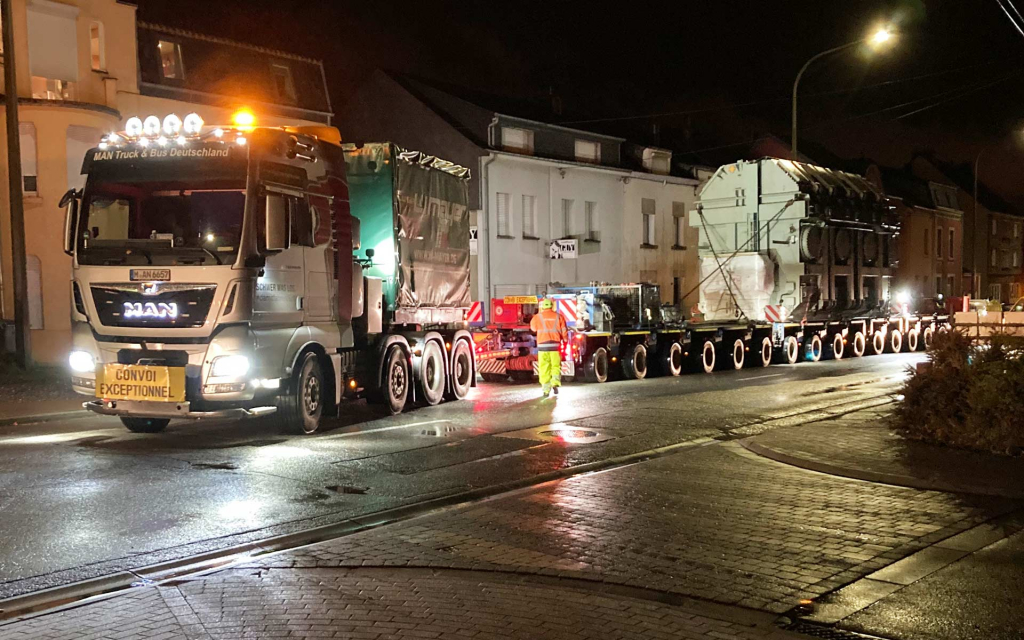
A powerhouse that offers extremely good performance
Three days of heavy-duty tests with the MAN TGX 41.640 – even for Steffen Richter, vehicle manager and technical trainer for special purpose and specialist vehicles at MAN, this was anything but an ordinary task.
He accompanied the heavy-duty semitrailer tractor and its driver, Olaf Rühle, in transporting a 205-tonne transformer from Liège to Aubange. Olaf was tasked by his company Heinrich Schwertransporte GmbH, which has been majority-owned by the Adams Group since 2010, to thoroughly test the heavy-duty MAN vehicle.
“And I got the chance to experience the sheer force and potential of our heavy-duty semitrailer tractor for myself too”.
Steffen Richter
640 hp and 3,000 Nm in use
In Liège, on a landing pier on the river Meuse, the heavy freight was loaded from a barge onto the 18-axle modular trailer (two times nine lines of axles with a steering support bar and hydraulic steering of all nine axles) using two loading cranes. Since late afternoon, the vehicle train had been on an approach road between the Meuse and the N90, waiting for the planned departure at 9 p.m. There’s plenty of time for Olaf and Steffen to discuss the technology, and what they expect from it in practice. According to Steffen, Olaf was quite happy with the explanation of the torque’s curve, the characteristics of the D38 engine, and the way in which the TCHD gearbox was coordinated with the efficient use of the converter-clutch unit. Olaf did try to warn him, however: “Steffen, that’s the theory, but you’ll see that it’ll work differently in practice. We will have to use full engine speed on the first incline of eight percent and for cornering, or we won’t manage it.” He and Steffen agree to at least try it once the way that Olaf, the professional driver, recommends, and once the MAN expert’s way.
At 10 p.m., the machine’s baptism of fire finally began, as Olaf brought the heavy vehicle train onto the N90 with great professionalism. Three kilometres in, the previously mentioned first obstacle was coming up, in the shape of an eight percent gradient and corners. Olaf started the incline and went to 2,000 rpm. “Let it drop to 1,900 rpm now, switch to manual, and when I say, go up a gear,” said Steffen. “Let the driver of the rear vehicle know in advance that you’re performing a load alteration and that he should stay in his gear and keep the pressure on.” Olaf regarded Steffen’s tip somewhat critically at first, then agreed, saying: “Okay, let’s try it. I could be wrong, and I’m happy to learn from you,” he said. After the load alteration was completed, the power dropped for a moment. “It’s getting serious – it won’t manage it,” said Olaf, clearly concerned. However, Steffen remained calm. “Give it a quick moment to build up the charging pressure. We’re now at 1,400 rpm, where it’s at its best, the highest torque. You’ll see – it’ll pull through.” In the engine compartment, there was a great roar, and the power from the 15.2 litres of the D38 could be felt. Olaf’s sceptical look changed to a grin, and the load made its way up the incline. After a couple of minutes on level ground, Steffen asked Olaf for his thoughts.
“That’s crazy. I never would have thought for a moment that it would manage it using only its torque range. I’m impressed! I am learning, and before the journey I thought, well, that’s the theory, but he’ll see how it is in practice. Now the vehicle, and you, have shown me that it really works.” The first stage was complete.
Steffen takes his turn
On the second night, the second round started at 9 p.m., following departure checks and a wait for the police. “So Steffen take the wheel. Now you’ll experience the machine and its weight for yourself,” said Olaf calmly, turning to his co-driver. Noticing his nerves, he gave him a couple of reassuring suggestions. Then it was time to engage the gear, to call the rear driver over the radio to say pressure was needed from the rear, and to release the parking brake. “What a feeling, when you get 340 tonnes moving,” Steffen reminisces. He pulled away, made a first lane change, kept communicating with the rear driver. “It was a challenge, but I could feel how the machine and the technology were responding to me.” After around 20 kilometres, the two drivers changed over again, as they were about to travel through several areas with narrow passages and several tight spots.
Professionals at work
Before the transformer could get to its final destination, it was necessary to navigate yet another hairpin bend on the third night. Steffen used the opportunity to observe the manoeuvre from outside and to film it. The enormous vehicle train got moving, and Olaf brought it around the bend comfortably. At 1,400 rpm, it stopped and a second tractor unit had to be attached too – also a baptism of fire for Nico, the driver of that vehicle. The driver of the rear vehicle pushed and the others then pulled in parallel. The three of them brought the vehicle train up the slope with great professionalism and concentration. “It’s incredible to think what people and machines have achieved here,” says Steffen.
But even Olaf was more than convinced by the MAN TGX 41.640 by the end of the trip. “I would never have imagined that it was possible to get so much power from the vehicle and the engine at low engine speeds or in the highest torque range. I am highly impressed by the D38.” Apart from convincing him of the vehicle’s power, the trip had another positive result. When professionals like Olaf and Steffen share their knowledge, they can learn a lot from each other.


